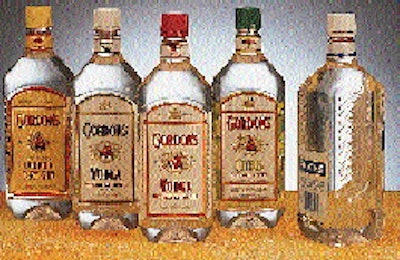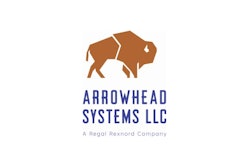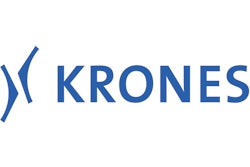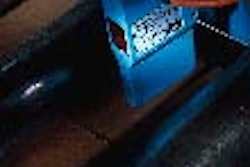Line 4 at United Distillers' Plainfield, IL, manufacturing plant produced 1.7 million cases of 1.75-L bottles of vodka and gin in 1996. That's 57% of the plant's total output. No wonder line efficiency is mandatory. In the past year, output on the line has increased by more than 3ꯠ cases per day. Better yet, the distiller has saved $400ꯠ on this line. Those savings are attributable primarily to two changes made last spring. The first was switching from ordering polyethylene terephthalate bottles in corrugated reshippers, to purchasing the PET bottles in bulk pallet loads. Second was using an H-Bliss-style case rather than the previous RSC reshipper. Knocked-down, Bliss-style case blanks are shipped separately. "Most of the savings are from reduced inbound freight costs," says plant manager Mark Fahey. "You can get roughly 50 percent more bottles on the truck in bulk than you can in reshippers," he says. "We also save on corrugated because we don't have to pay the upcharge for the supplier to set up cases and fill them with empty bottles." Plant engineer Bob Patel adds, "At the time we were using reshippers, corrugated costs were getting out of hand. The Bliss box uses 15 percent less corrugated than the reshipper, so we created some significant material savings." And while the line still produces 1.7 million cases annually, the changes have increased output efficiency. Patel explains that by producing more than 3ꯠ additional cases per day on the line, United can meet market demand in far fewer production days. That frees personnel to staff the other four production lines at Plainfield. "There are tremendous labor savings," he admits, although specific figures were not revealed. The added efficiency stems from new and/or upgraded equipment, all added within the past 16 months. The machinery includes: * A Busse (Randolph, WI) depalletizer and Moen Industries (Santa Fe Springs, CA) case erectors. They help United produce about 14ꯠ cases/day, compared to just over 10ꯠ/day with previous semi-automatic depalletizing and uncasing. Pallet loads of reshippers were conveyed to the former depalletizer that lifted one tier of boxes at a time from the pallet into position for two operators to remove boxes and place them on a conveyor for downstream operations; * A customized high-speed case taper (see sidebar, p. 46) that produces 55 cases/min, 27% more cases than the former hot melt unit; * New inspection systems from Heuft USA (Downers Grove, IL) and Imagineering Systems (Wheeling, IL) that improve inspection of fill height/cap placement, and label placement, respectively. A previous inspection system could not detect overfills. Label placement was checked visually by line personnel. Custom bottles Line 4 produces Gordon's® vodka in 80- and 100-proof versions, citrus-flavored vodka, Gordon's distilled London dry gin, and Booth's® gin. A rotary 40-valve filler handles approximately 250 bottles/min, the same as when reshippers were used. Speed, says Fahey, was not a factor in the switch to bulk bottles. The line usually runs eight hours/day, four days/wk, although that will increase to meet heavier market demand in the summer and during the holiday season. Johnson Controls (Manchester, MI) injection/stretch blow-molds the customized bottles using Eastman Chemical's (Kingsport, TN) 9663 PET resin. No bottle changes have been made since ordering bottles in bulk. The 83-g square-shaped bottles feature two ribbed side gripping panels, with the Gordon's brand name embossed vertically alongside these panels. Recessed areas provide room for a large winged front-panel label that includes brand name and logo, and a smaller back-panel label containing a bar code and various product information. PET paves the way PET bottles replaced glass for these spirits about two years ago. Patel describes the switch as the first of a two-phase project. The second phase was the change from reshippers to bulk bottles. "There was about a $1 per case material savings with PET compared to glass," asserts Fahey. "On top of that, there's less breakage that causes material waste and line downtime. Plus, the lighter-weight plastic bottles created considerable per case shipping savings for finished product. "The PET bottle weighs about three ounces," Fahey adds, "while the glass weighed about 36 ounces. That's about a 12-pound-per-case weight savings. In shipping, you're able to load a truck up to 80ꯠ pounds gross weight, so the lighter plastic bottle allows us to get more product onto each load." The $400ꯠ savings, however, is not related to the switch to PET bottles. Most savings stem from the added efficiency. Approximately 15% come from reduced inbound trucking charges. The balance is from using 15% less corrugated material for the 1.7 million cases shipped annually. Line efficiency increases The new equipment on Line 4 was up and running in April. The upgraded line begins as an operator uses a forklift truck to deliver a pallet load of bottles onto the infeed conveyor of the Busse Turbo depalletizer. Each pallet has eight layers of bottles, with 130 bottles per tier. Stretch wrap film is manually removed and discarded, though Fahey says United is researching the economics of recycling the film. The pallet is conveyed into a hoist area that raises the pallet to a mezzanine level. The top layer of bottles is swept onto a conveyor. Bottles are conveyed downstream past a diverter that single-files them. Next, bottles proceed down a lowerator conveyor to a Krones (Franklin, WI) orienter that orients them in the same direction for downstream label application. Bottles proceed through a wall opening where a laser coder etches a production code onto the back of the bottle, near its base. Afterwards, bottles are automatically inverted, cleaned by air, then uprighted. Gentler inspection Cleaned bottles proceed into a filling/capping block. The 40-head rotary filler and capper were installed in '81. The capper applies injection-molded polypropylene closures that are color-coordinated to match front, back and neck labels for each of the five varieties. The 33-489 closures also provide a tamper-evident ring. As bottles exit the block, a Heuft basic inspection device detects missing or cocked closures, as well as under- and overfills. "Before we added this system last spring, we couldn't detect high fills," Fahey points out. Not being able to detect overfills was a concern for bottles in hot weather conditions. As Fahey explains, the alcohol is filled at ambient air temperatures. At hotter storage temperatures, the liquid expands. When United Distillers used glass bottles, this posed a safety problem in some bottles that occasionally shattered. Esthetic appeal is the problem with overfilled plastic bottles exposed to higher temperatures as bottle panels tend to balloon. The main reason United switched to the Heuft device, however, had to do with the limitations of the previous inspector's reject system. That was especially true in the case of filled bottles with missing or cocked closures. "The former inspection device left a lot to be desired in that it used a push arm for rejects," says Fahey. "When the push arm contacted these bottles, it occasionally squeezed product out of the bottle, or pushed the bottle off the line onto the floor. That caused product spillage and downtime." With the Heuft system, information gathered by three detection heads is used to make a go/no-go decision. Satisfactory bottles continue downstream; rejected bottles proceed to a takeaway conveyor. Instead of being "pushed" off-line, these bottles ride along a curved segmented conveyor section. A pneumatic cylinder activates each segment. Bottles ride along these segments, which are arranged in a shortest-to-longest pattern that curves into the takeaway conveyor. Satisfactory bottles proceed to a Krones Solomatic labeler. Downstream, the inspection device provided by Imagineering Systems checks for missing or misplaced labels. "This system is another upgrade for us," says Fahey. "In the past we had two people visually inspecting labels. We still use those people for various tasks on the line, but with the inspection system, we can more consistently check label placement accuracy. We feel our emphasis on inspection is a good customer service practice." Help wanted After label inspection, bottles are conveyed to one of two drop packers positioned on either side of the line. Each packer operates at speeds up to 28 cases/min. While the units function properly, the spirits producer hopes to upgrade this operation in the near future. "We're always on the lookout for more efficient machinery," says Patel. "Ideally," Fahey adds, "we'd like to find one continuous-motion machine that could run between 50 and 60 cases of these square-shaped bottles per minute. We think there'd be a lot of interest in this kind of machine if it's priced reasonably and it doesn't require excess floor space." Each drop packer gently positions six bottles into a two-piece H-Bliss-style shipper from Inland Paperboard & Packaging (Indianapolis, IN). Inland prints cases flexographically in four colors. Two panels are perforated so that retailers can use them as display cases in the store. The 200#-test, C-flute corrugated case is erected in two steps on the Moen Model PF106-HLV formers. First, the divider blank is formed, glued and folded into an H-shape. Then a body blank is formed around the H-divider. The result is that the divider itself, rather than the main body blank, becomes the two case ends. That saves on material usage, as does the fact that the case has no minor flaps. The glue sets in the compression station and the case is conveyed to the two drop packers. "With reshippers, we experienced considerable downtime during case packing," Patel recalls. "Almost all of the downtime was the result of having to use the packers to open the leading flap of the reshipper case. That flap caused problems and slowed us down. By using a case that has no minor flaps, we've eliminated a major bottleneck." Packed cases are then taped. Afterwards, they pass an older inspection system that checks for six bottles within each case. Downstream, cases are automatically palletized, and pallet loads are stretch-wrapped in film. Loads are transported into trucks for delivery to all 50 states. Less than 5% of the plant's volume is exported. The 200ꯠ-square-foot Plainfield plant is United Distillers' only U.S. plant producing the well-known Gordon's gin and vodka products. Of the plant's five filling lines, Fahey says Line 4 is the most advanced in terms of packaging technology. "We invest in our lines on a continuous basis to try to improve line efficiencies," says Patel. "There's always a new area where we feel we can make improvements and reduce our labor or energy consumption costs. Output is a key concern of ours." That concern has been (and will continue to be) addressed, particularly on Line 4 where the recent machinery upgrades, the switch to bulk shipments of PET bottles, and the use of the H-Bliss-style case makes the line's efficiency a match for its considerable production demands.






























